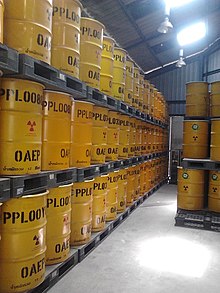
Back Sawalakay a lakaw AMI مخلفات إشعاعية Arabic Radioaktiv tullantılar Azerbaijani Радиоактивни отпадъци Bulgarian Lastez nukleel Breton Residu radioactiu Catalan Radioaktivní odpad Czech Радиоактивлă каяш CV Gwastraff niwclear Welsh Radioaktivt affald Danish

| Part of a series on |
| Pollution |
|---|
 |
Radioactive waste is a type of hazardous waste that contains radioactive material. Radioactive waste is a result of many activities, including nuclear medicine, nuclear research, nuclear power generation, nuclear decommissioning, rare-earth mining, and nuclear weapons reprocessing.[1] The storage and disposal of radioactive waste is regulated by government agencies in order to protect human health and the environment.
Radioactive waste is broadly classified into 3 categories: low-level waste (LLW), such as paper, rags, tools, clothing, which contain small amounts of mostly short-lived radioactivity; intermediate-level waste (ILW), which contains higher amounts of radioactivity and requires some shielding; and high-level waste (HLW), which is highly radioactive and hot due to decay heat, thus requiring cooling and shielding.
In nuclear reprocessing plants about 96% of spent nuclear fuel is recycled back into uranium-based and mixed-oxide (MOX) fuels. The residual 4% is minor actinides and fission products the latter of which are a mixture of stable and quickly decaying (most likely already having decayed in the spent fuel pool) elements, medium lived fission products such as strontium-90 and caesium-137 and finally seven long-lived fission products with half lives in the hundreds of thousands to millions of years. The minor actinides meanwhile are heavy elements other than uranium and plutonium which are created by neutron capture. Their half lives range from years to millions of years and as alpha emitters they are particularly radiotoxic. While there are proposed - and to a much lesser extent current - uses of all those elements, commercial scale reprocessing using the PUREX-process disposes of them as waste together with the fission products. The waste is subsequently converted into a glass-like ceramic for storage in a deep geological repository.
The time radioactive waste must be stored for depends on the type of waste and radioactive isotopes it contains. Short-term approaches to radioactive waste storage have been segregation and storage on the surface or near-surface. Burial in a deep geological repository is a favored solution for long-term storage of high-level waste, while re-use and transmutation are favored solutions for reducing the HLW inventory. Boundaries to recycling of spent nuclear fuel are regulatory and economic as well as the issue of radioactive contamination if chemical separation processes cannot achieve a very high purity. Furthermore, elements may be present in both useful and troublesome isotopes, which would require costly and energy intensive isotope separation for their use - a currently uneconomic prospect.
A summary of the amounts of radioactive waste and management approaches for most developed countries are presented and reviewed periodically as part of a joint convention of the International Atomic Energy Agency (IAEA).[2]
- ^ "The Geological Society of London - Geological Disposal of Radioactive Waste". www.geolsoc.org.uk. Retrieved 2020-03-12.
- ^ "The Joint Convention". IAEA. Archived from the original on 2010-03-28.
© MMXXIII Rich X Search. We shall prevail. All rights reserved. Rich X Search